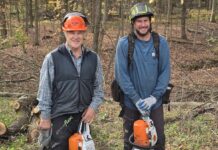STILLWATER, Okla. — In movies it is not unusual to see a cowboy ride his horse forever, through all types of weather and terrain; in reality, horses are equine athletes that must be properly conditioned to perform as needed.
“The general design of an equine conditioning program — especially for horses that have been relatively idle for several months — is similar to those designed for people: Start with backgrounding and work toward more and more skill-specific activities,” said Dave Freeman, Oklahoma State University Cooperative Extension equine specialist.
Backgrounding. Backgrounding uses low-intensity exercise, ideally multiple sessions a day rather than one extensive session. Low intensity lets a horse manager more easily monitor how conditioned the animal is aerobically while guarding against fatigue of tendons, ligaments, bones, joints and muscle.
“Keeping session length down guards against bone injuries caused by miss-striding from muscle and tendon fatigue,” Freeman said. “Also, proper shoeing and exercising on surfaces with cushion will help a previously idle horse guard against excessive stress on bone, tendons and ligaments.”
Building aerobic stamina
One of the desired effects of physical conditioning is in building aerobic stamina of the cardiovascular system. By doing so, the horse becomes more efficient at delivery, use and release of body chemicals and compounds integrated with performance of exercise.
“The result is an increased ability to perform moderate work for a longer period of time, as well as an improved ability to decrease stress from performing a specific level of work,” said Tommy Puffinbarger, Alfalfa County Extension agricultural educator and longtime horse owner.
Aerobic conditioning for horses is built up by exercising at levels that require heart rates around 150 beats per minute or more. Desired fitness level directs the length of a session. Puffinbarger said unfit horses may reach these rates by loping for as little as several minutes or trotting for a slightly longer time in a single bout of exercise.
“It’s not uncommon for an unfit horse to get in 10 minutes or less at these work levels before a session needs to be stopped or exercise intensity reduced for several minutes to allow the animal to recover before more exercise is performed,” he said. “Don’t get discouraged. The idea is to work up to desired levels of fitness in a way that is healthy for the horse.”
It is important to remember that aerobic fitness in a previously idle horse may come back more quickly than the conditioning of the equine’s muscular and skeletal system.
Horse health
“Conditioning causes stress on the horse’s skeletal system,” Freeman said. “When stressed correctly, bone strain can be reduced by as much as 40 percent with training.”
Bone tissue responds to short periods of cyclical loading, meaning that multiple short-duration sessions of moderate-to-intense exercise is preferred over long periods of galloping.
“Long periods of exercise introduced too rapidly — especially on hard surfaces — can lead to microfractures, and microfractures can lead to fractures or at least the build-up of secondary bone,” Freeman said.
Secondary bone is not as strong as the bone it replaced. Also, introducing long periods of conditioning too rapidly has the potential to promote abnormal gait stride that can, in turn, increase strain on the horse’s bones.
Tendons and ligaments also respond to conditioning. Unfortunately, responses are not positive most of the time. Tendinitis is common in horses undergoing training; published estimates suggest as many as 40 percent of performance horses show measurable evidence, with the number increasing relative to the age of the animal.
“Training during a horse’s younger riding years is generally helpful in developing the quality of tendons and minimizing the degenerative effects of training at older ages,” Freeman said. “Just be aware that tendons are still growing in young horses, perhaps making them more susceptible to injury, so keep a close eye on them.”
Right amount of stress
In short, stress is required to increase a horse’s fitness, but too much stress, too soon in an equine fitness program will cause physical failure in the animal.
“Picture a good fitness program as a series of steps designed around exercise intensity and length,” Puffinbarger said. “As the horse becomes increasingly fit the intensity may be increased relative to the same length of exercise or the length of a session may be increased relative to the same intensity level, much the same as with a human athlete in training. In time, the horse should be able to work harder, longer.”
Heart rate response is the most uniform, accurate method of monitoring how stressed a horse is during an exercise bout. Heart rate monitors that allow checks during exercise are commercially available, but can be somewhat costly. Monitors that allow checks of heart rate while a horse is standing are typically less expensive.
“Monitors used to identify a horse’s heart rate immediately after exercise will provide a fairly accurate benchmark of fitness,” Freeman said. “If heart rate monitors are not used then the horse’s gait, respiration rate and other observable physical responses have to be evaluated to estimate the degree of cardiovascular fitness.”
As a horse’s level of fitness is increased, recovery heart rate from bouts of exercise to levels expected at rest will occur more rapidly, especially responses noted within the first 10 minutes.









